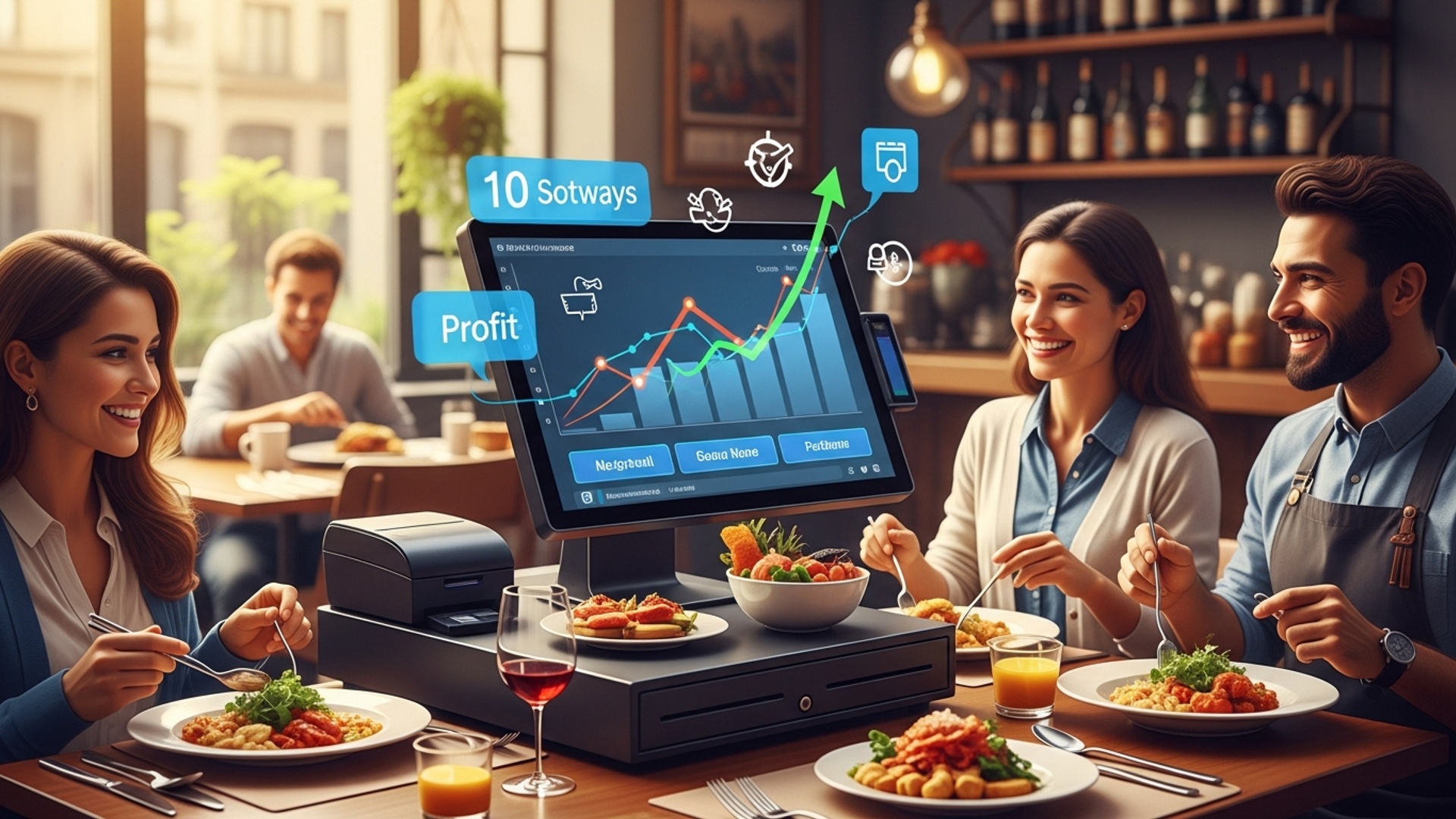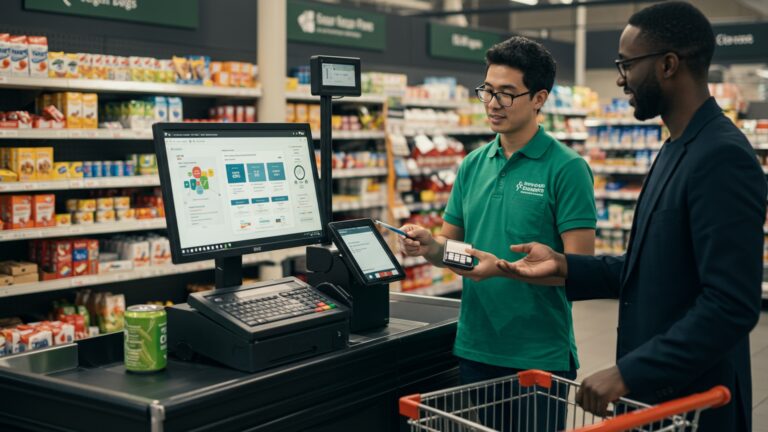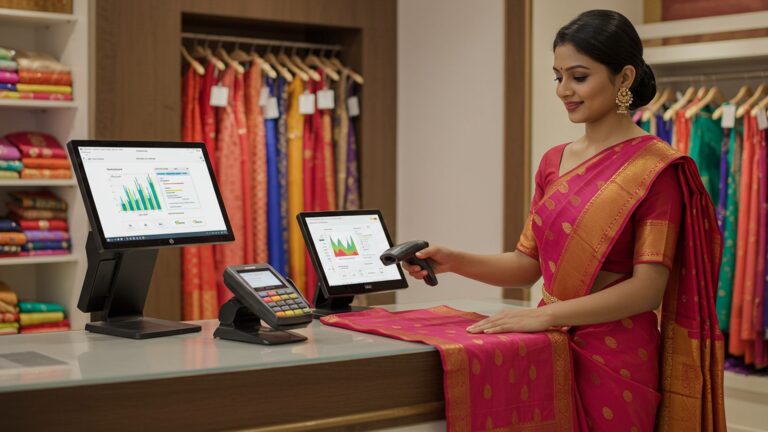Discover 10 Ways Restaurant POS Software Can Grow Your Business Profitably
Navigating the modern restaurant industry’s tight margins and ever-evolving consumer demands requires more than just efficient order taking; it demands a strategic operational powerhouse. Modern restaurant POS software has transformed into this indispensable tool, leveraging recent advancements in cloud technology and AI to unlock profitability across multiple fronts. Imagine systems that precisely manage inventory, drastically cutting food waste, or personalize customer loyalty programs that convert first-time diners into regulars. These integrated platforms streamline everything from online ordering and kitchen workflows to real-time sales analytics, empowering owners to optimize labor costs, enhance table turnover. craft data-driven menus. Such a comprehensive technological backbone directly fuels sustainable business growth.

The Foundation: Understanding Restaurant POS Software
Before diving into how it can revolutionize your business, let’s establish a clear understanding of what Restaurant POS software (Point of Sale) actually is. At its core, a POS system is more than just a cash register; it’s an integrated technology solution designed to manage all aspects of restaurant operations, from order taking and payment processing to inventory management and customer relationship tracking. Modern Restaurant POS software acts as the central nervous system for your establishment, connecting front-of-house activities with back-of-house functions to create a seamless, efficient. data-rich environment. It’s the digital backbone that empowers restaurants to operate smarter, not just harder.
1. Streamlined Order Management for Unprecedented Speed and Accuracy
One of the most immediate and impactful benefits of robust Restaurant POS software is its ability to transform order management. Traditional manual order-taking is prone to errors, slow. can lead to frustrated customers and wasted food. A modern POS system digitizes this entire process.
- Digital Order Entry: Servers can take orders directly on handheld devices (tablets or smartphones) that instantly transmit to the kitchen or bar. This eliminates handwriting errors and speeds up service.
- Kitchen Display Systems (KDS): Instead of paper tickets, orders appear on screens in the kitchen, organized by course, table, or prep station. Chefs can prioritize, mark items as prepared. communicate delays.
- Real-world Application: Consider a bustling downtown bistro that previously struggled with miscommunication between servers and the kitchen during peak dinner rushes. Implementing a POS with integrated KDS reduced order errors by an estimated 25% and shaved an average of 5-7 minutes off ticket times, directly contributing to higher table turnover and increased customer satisfaction. This efficiency allows staff to focus more on guest experience rather than logistical headaches.
2. Precision Inventory Control to Minimize Waste and Maximize Savings
Food costs are a significant expense for any restaurant. inefficient inventory management can lead to substantial losses through spoilage, waste. theft. Restaurant POS software provides sophisticated tools to gain granular control over your stock.
- Automated Inventory Tracking: Every dish sold automatically deducts ingredients from your inventory counts. When a burger is ordered, the system reduces your beef patties, buns, cheese. vegetables accordingly.
- Recipe Management: Define precise recipes within the POS, detailing exact ingredient quantities. This ensures consistency and accurate cost calculation per dish.
- Automated Reordering: Set minimum stock levels. the system can automatically generate purchase orders when supplies run low, or alert you to do so.
Comparison: Manual vs. POS-Driven Inventory
| Feature | Manual Inventory | POS-Driven Inventory |
|---|---|---|
| Accuracy | Prone to human error, estimates | High, real-time, data-driven |
| Time Spent | Hours weekly/daily counting | Automated, minimal manual input |
| Waste Reduction | Difficult to track, higher spoilage | Identifies waste, optimizes purchasing |
| Cost Control | Reactive, less precise | Proactive, detailed ingredient costing |
| Theft Prevention | Hard to detect discrepancies | Highlights variances, increases accountability |
By preventing over-ordering and identifying popular vs. slow-moving items, a robust POS can significantly cut down on food waste, turning potential losses into profit.
3. Optimized Table Management and Seating Efficiency
For dine-in establishments, managing tables effectively is crucial for maximizing capacity and customer satisfaction. A sophisticated Restaurant POS software offers intuitive table management features.
- Visual Floor Plan: A digital representation of your restaurant layout allows staff to see which tables are occupied, available, or about to finish.
- Reservation Management: Integrate with online reservation systems to manage bookings, minimize no-shows. allocate tables efficiently.
- Waitlist Management: For walk-ins during busy periods, a digital waitlist allows hosts to accurately estimate wait times, send SMS notifications. seat guests as soon as tables become free.
Actionable Takeaway: By optimizing table turns and reducing customer wait times, restaurants can serve more guests without increasing overhead, leading directly to higher revenue per hour. A small increase in table turns can have a profound impact on daily profits.
4. Elevating Customer Relationships with Integrated CRM
Repeat customers are the lifeblood of any successful restaurant. Modern Restaurant POS software extends beyond transactions to help you build stronger relationships with your patrons through integrated Customer Relationship Management (CRM) functionalities.
- Customer Profiles: Capture customer data like order history, dietary preferences, birthdays. contact details.
- Loyalty Programs: Easily implement and manage points-based systems, tiered rewards, or special discounts for loyal customers. The POS tracks points earned and redeemed.
- Personalized Marketing: Use collected data to send targeted promotions, birthday offers, or recommendations based on past orders. For instance, a coffee shop could use their POS data to identify customers who frequently buy espresso drinks and send them a special offer on a new seasonal latte.
This level of personalization makes customers feel valued, encouraging them to return more frequently and spend more when they do.
5. Data-Driven Decision Making Through Robust Analytics
The true power of Restaurant POS software lies in the wealth of data it collects. Every transaction, every inventory movement. every customer interaction generates valuable insights that, when properly analyzed, can guide strategic business decisions.
- Comprehensive Sales Reports: interpret daily, weekly. monthly sales trends; identify peak hours; and assess sales by menu item, category, or server.
- Menu Performance Analytics: Discover which dishes are top sellers, which are underperforming. their respective profit margins. This informs menu engineering decisions.
- Labor Cost Analysis: Track employee hours against sales to optimize staffing levels and reduce unnecessary labor expenses during slow periods.
As industry experts at Toast, a leading POS provider, often emphasize, “Data is the new currency for restaurants.” By leveraging the reporting features of your POS, you can move away from guesswork and make informed decisions about menu changes, pricing strategies, marketing campaigns. even expansion plans. For example, a restaurant owner discovered through their POS reports that their expensive seafood pasta sold poorly during lunch but was a huge hit at dinner. They adjusted the lunch menu, replacing it with a more cost-effective and popular item, thereby increasing lunch profitability without alienating their dinner crowd.
6. Reducing Labor Costs and Boosting Operational Efficiency
Labor is another significant operational cost for restaurants. Restaurant POS software helps optimize staffing and streamline tasks, leading to considerable savings and improved efficiency.
- Integrated Time Clock: Employees can clock in and out directly through the POS, ensuring accurate timekeeping and simplifying payroll processing. This eliminates manual punch cards and potential discrepancies.
- Simplified Training: Modern POS interfaces are often intuitive and user-friendly, significantly reducing the time and resources required to train new staff members.
- Automated Tasks: Features like automatic gratuity calculation for large parties, split checks. seamless table transfers reduce manual effort and potential errors for servers.
Case Study: A popular chain of fast-casual eateries implemented a new POS system that cut down average employee training time from three days to one. This reduction, combined with automated payroll integration, saved the company an estimated $500 per new hire in training costs and administrative time, allowing staff to become productive faster and contribute to the bottom line sooner.
7. Enhancing Security and Preventing Fraud
Restaurants, unfortunately, can be vulnerable to various forms of fraud, both internal and external. A robust Restaurant POS software provides several layers of security to protect your profits.
- Transaction Tracking: Every transaction, void, discount. refund is logged with a timestamp and the employee who processed it, creating a transparent audit trail.
- User Permissions: Assign different access levels to staff. For example, only managers might have the ability to approve voids or apply significant discounts.
- Cash Drawer Management: Integrated cash drawers track cash flow meticulously, reducing discrepancies and making it easier to reconcile at the end of a shift.
Real-world Scenario: A restaurant was experiencing unexplained cash shortages. Their new POS system’s detailed void and discount reports quickly highlighted a pattern: a particular server was frequently voiding high-value orders after they were paid for in cash. The granular data provided by the POS enabled management to address the issue directly and prevent further losses, demonstrating its critical role in loss prevention.
8. Expanding Reach with Multi-Channel Order Acceptance
In today’s competitive landscape, limiting sales to dine-in customers means leaving money on the table. Restaurant POS software is pivotal in enabling multi-channel revenue streams, essential for modern business growth.
- Integrated Online Ordering: Many POS systems offer native online ordering platforms or integrate seamlessly with third-party providers. Customers can place orders directly from your website, which feed straight into your KDS.
- Third-Party Delivery Integration: Connect with popular delivery services like DoorDash, Uber Eats. Grubhub. Instead of managing multiple tablets, orders from these platforms can flow directly into your POS, simplifying operations and preventing missed orders.
- Takeout and Curbside Pickup: The POS helps manage these orders efficiently, ensuring food is ready on time and staff can coordinate pickups smoothly.
This expansion into online and delivery channels allows restaurants to tap into a wider customer base, especially those who prefer convenience or are outside the traditional dine-in demographic. For instance, during the pandemic, restaurants that quickly adopted or upgraded their POS to handle online orders were far more resilient and often saw significant growth in their takeout and delivery revenue streams.
9. Efficient and Diverse Payment Processing
A smooth and secure payment experience is crucial for customer satisfaction and operational efficiency. Modern Restaurant POS software excels in offering flexible and fast payment processing options.
- Multiple Payment Types: Accept cash, credit/debit cards (EMV chip cards), contactless payments (NFC like Apple Pay, Google Pay). mobile payments with ease.
- Faster Checkout: Integrated payment processing reduces transaction times, especially with tap-to-pay options, speeding up lines and increasing table turns.
- Enhanced Security: Robust POS systems comply with PCI DSS standards and often use end-to-end encryption for transactions, protecting sensitive customer data and reducing your liability.
Comparison of Payment Methods via POS:
| Payment Method | Speed | Security (via POS) | Customer Convenience |
|---|---|---|---|
| Cash | Fast, requires manual handling | Low (prone to human error/theft) | Medium (requires physical currency) |
| Swipe (Magstripe) | Medium | Lower (less secure against fraud) | Medium |
| EMV Chip Card | Medium to Fast | High (fraud prevention) | High |
| Contactless (NFC) | Very Fast (tap-to-pay) | High (encrypted) | Very High (mobile phone/watch) |
| Mobile Wallets | Very Fast | Very High (tokenization) | Very High (secure, easy) |
By offering diverse payment options, restaurants cater to customer preferences, reduce friction at checkout. ensure secure transactions, all contributing to a more profitable and customer-friendly operation.
10. Strategic Menu Engineering for Maximum Profitability
Your menu is more than just a list of dishes; it’s a strategic tool for profitability. Restaurant POS software provides the data necessary to perform effective menu engineering, which involves analyzing the popularity and profitability of each item to optimize your offerings.
- Ingredient Costing: Accurately calculate the cost of each dish based on real-time ingredient prices and recipe specifications.
- Profitability Matrix: Categorize dishes based on their popularity (sales volume) and profitability (gross margin). This allows you to identify:
- Stars: High popularity, high profitability (Promote them!)
- Plow Horses: High popularity, low profitability (Can you increase price or reduce cost?)
- Puzzles: Low popularity, high profitability (Can you market them better?)
- Dogs: Low popularity, low profitability (Consider removing them!)
- Pricing Optimization: Use data to inform pricing decisions. If a “Plow Horse” is a must-keep item but has low margins, a slight price adjustment might make it more profitable without deterring sales.
Example: A casual dining restaurant used their Restaurant POS software to assess its menu. They discovered that their highly popular “Signature Burger” was a “Plow Horse” due to rising beef costs and a low selling price. By slightly increasing its price by $1 and cross-promoting a higher-margin “Gourmet Chicken Sandwich” (a “Puzzle”), they significantly improved their overall food cost percentage and increased net profits by 3% over the quarter without losing customer loyalty. This strategic use of POS data turns your menu into a finely tuned profit-generating machine.
Conclusion
Embracing modern restaurant POS software isn’t merely an operational upgrade; it’s a strategic investment in your business’s future profitability. We’ve explored how functionalities like real-time inventory management can significantly reduce waste, turning potential losses into savings, just as a local café recently reduced their daily pastry spoilage by nearly 20% through precise sales tracking. In today’s competitive landscape, leveraging robust POS data for personalized customer engagement, a critical trend, allows you to craft targeted promotions, boosting repeat business and average check sizes. My personal tip? Don’t just install a system; actively engage with its reporting features. The true power lies in the insights you extract, allowing you to fine-tune everything from peak-hour staffing to your most profitable menu items. It’s about making informed decisions, not just processing transactions. The market is constantly evolving, with recent developments in AI-driven predictive analytics integrated into leading POS solutions offering unprecedented foresight. Therefore, if you haven’t yet explored the comprehensive capabilities of advanced POS, now is the opportune moment. Take that decisive step; your future growth and profitability depend on it.
More Articles
Master 8 Key Features to Look For in Restaurant POS Software
Learn 7 Ways Restaurant POS Software Boosts Your Business Efficiency
How to Choose the Best Restaurant POS System 7 Essential Tips
Why 8 Restaurant Owners Are Upgrading Their POS Systems Now
FAQs
How does restaurant POS software actually help my business make more money?
It boosts profits by streamlining operations, reducing errors, improving customer service for repeat business. providing data to make smarter decisions about your menu and staffing.
Can a POS system really help me cut down on operational costs?
Absolutely! It minimizes waste through accurate inventory tracking, reduces labor costs by improving order accuracy and staff efficiency. helps identify areas where you might be overspending.
What about boosting sales and keeping customers happy?
By speeding up order taking and processing, ensuring accuracy. even managing loyalty programs, it creates a smoother experience. Happy customers are more likely to return and spend more, plus it can suggest upsells.
I struggle with food waste. Can POS software fix that?
Yes, it’s a game-changer for inventory! It tracks ingredients as they’re used, alerts you when stock is low. helps predict demand, significantly reducing spoilage and over-ordering. No more guessing what you have in the back!
What kind of useful insights does a POS system give me to make better business choices?
You get detailed reports on your best-selling items, peak hours, staff performance. more. This data lets you optimize your menu, schedule staff effectively. identify new opportunities for growth.
With everyone ordering online these days, how does POS software fit into that?
Modern POS systems often integrate seamlessly with online ordering platforms and third-party delivery services. This centralizes all orders, whether dine-in, takeout, or delivery, making management much simpler and expanding your reach.
My team is busy. Will a POS system make their jobs easier or harder?
Much easier! It simplifies order entry, table management. payment processing. This frees up your staff to focus more on customer service rather than tedious tasks, leading to better productivity and a happier team.



